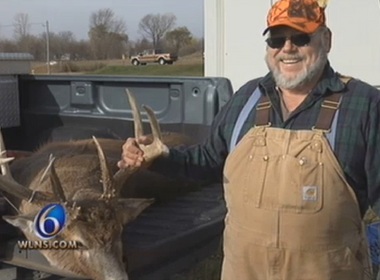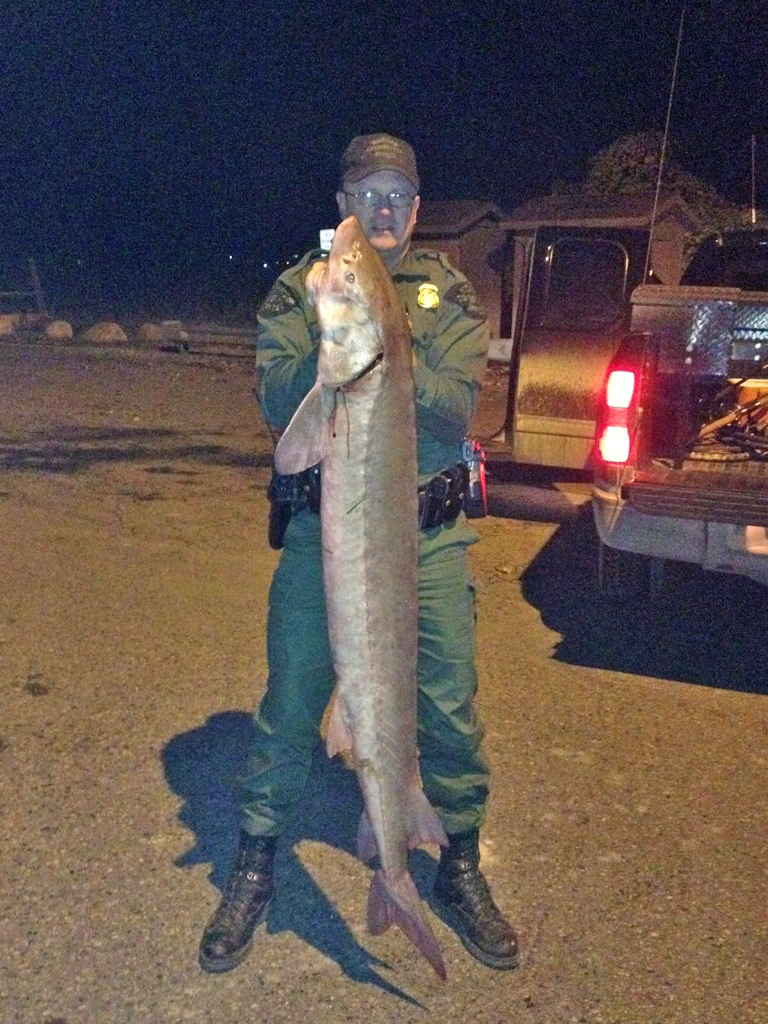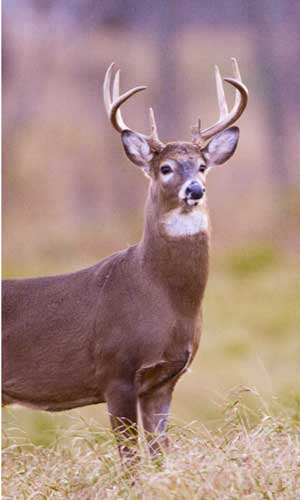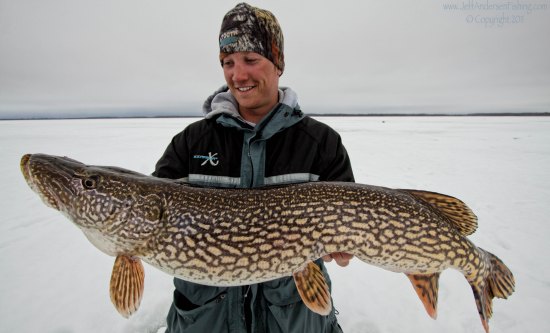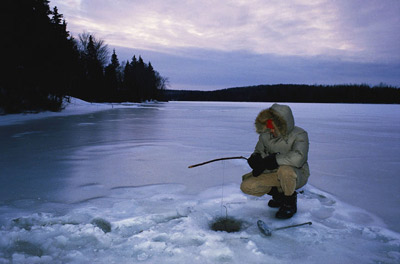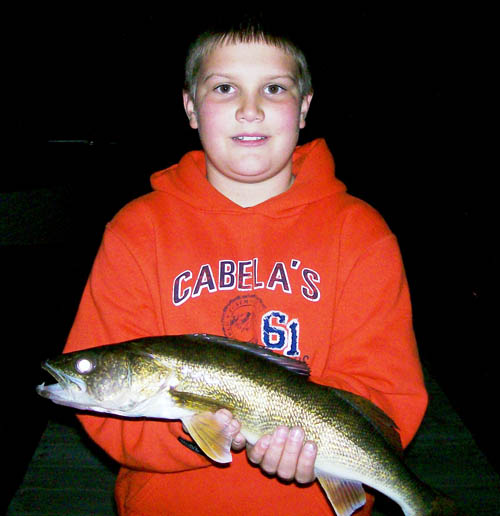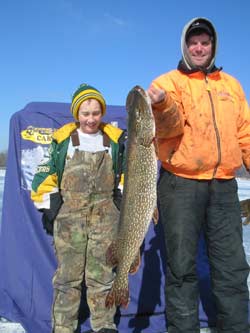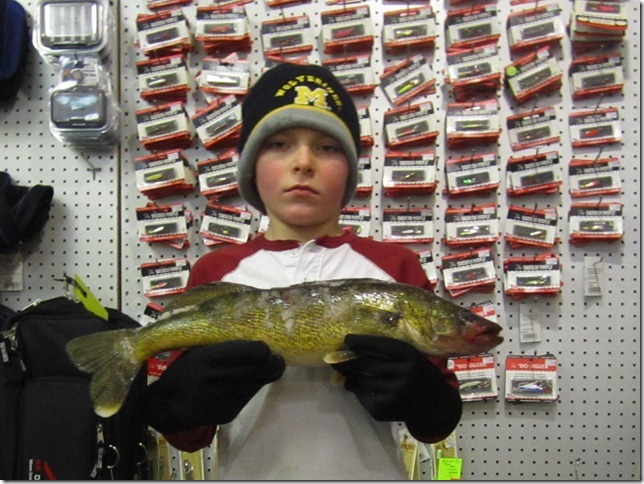 Michigan Fishing Report for 10/26/12
Michigan Fishing Report for 10/26/12
As the fall salmon run winds down, steelhead activity picks up. In the rivers, water levels are up a bit after all the rain. Those with a good current should have a fair to good number of steelhead moving in. This is the time of year to catch muskie and pike because they go on a feeding frenzy. Inland lakes are usually good for panfish this time of year.
I’m hearing of a good perch bite on Elk and Skegemog Lake for perch this week with wigglers and minnows working best. Also smallies have been on the bite. Manistee Lake by Kalkaska has a good walleye bite also
Northwest Lower Peninsula Fishing Report
Indian River Perch fishing has been pretty good on Burt and Mullett Lake. Fish up to 15 inches have been caught. A few walleyes are hitting, too. Waterfowl hunting has been pretty good, and the archery deer season is off to a good start. Deer numbers are up a little.
Petoskey: Anglers harvested some fish past the mouth of the river, but many were thrown back because they were in pretty bad shape. Waders and anglers fishing off the rocks near the “bobber hole” were using spoons, flies, spawn bags, and skein. Most were fishing in the river, but some are fishing off the beach near the breakwall and off the piers with spoons or spawn. They have caught chinook, a couple pink salmon and coho.
Bear River: The number of anglers as well as the number of salmon has declined. Water levels were up and the current was fast after the rain. Anglers using spawn, skein, artificial eggs or yarn have caught coho and pink salmon. A couple steelhead were taken but anglers are still waiting for that run to get started. Pink salmon were caught near the mouth and a 27 inch lake trout was caught on pink yarn at the dam.
Charlevoix: Fishing was slow but steelhead and menominee whitefish were caught on a single egg just off the bottom near the Cement Plant. A few boats just off the pier may have been targeting perch. The area near Medusa Creek has slowed down quite a bit. The few anglers out there were using spoons, spawn bags, and single eggs.
Traverse City: Anglers were mostly targeting perch, smallmouth bass, whitefish and cisco. Perch anglers were still-fishing with minnows, wigglers or shrimp. Most of the fish caught were small but those willing to sort out the small ones can still get enough fish to take home. Cisco were caught by those jigging 50 to 100 feet down in 80 to 120 feet of water. Perch fishing has been good on South Lake Leelanau, Long Lake, Big Glenn Lake, and East and West Bays.
Elk River: Chinook, coho, steelhead, and lake trout have been caught near the power dam by those using spawn bags. Many of the coho are fresh but most of the chinook are deteriorating. More steelhead are starting to show up. The fish are averaging 6 to 8 pounds.
Boardman River: The weir has been lifted. Anglers were targeting salmon, steelhead, and lake trout. Most of the remaining chinook salmon are in poor condition. The coho are in good shape and anglers should see more steelhead coming into the river very soon. Skein and spawn bags are producing the best.
Frankfort: Both the Elberta and Frankfort breakwalls have been producing good catches of steelhead ranging 8 to 10 pounds. Most are using chartreuse and pink spawn bags with glow floats. The early morning bite was best as the action was hit-or-miss throughout the day. Those able to get out to the Bank did find three year old chinook, coho and steelhead 40 to 100 feet down in 150 to 200 feet of water.
Onekama: The North Pier is still showing activity for coho and steelhead. They are hitting on spawn bags in the early morning. Those casting glow spoons in the pre-dawn have caught a couple steelhead.
Portage Lake: Water levels are very low so the fish are in much deeper water. Bass and panfish were caught in 18 to 22 feet.
Manistee: Pier anglers and those surfcasting are catching steelhead when conditions are right. They are fishing off the piers and the beaches.
Manistee River: Salmon are on the definite downslide. Fish are still there but most are actively spawning and therefore not biting. Recent rain did bring some nice chrome steelhead into the river.
Ludington: Pier and surf anglers are catching steelhead when using salmon spawn.
Pere Marquette River: Rain did push steelhead up into the river. Most fish were caught on spawn. Those looking for salmon will still find a few fish however they are almost done spawning so they are not hitting anything.
Pentwater: Pier anglers still-fishing with spawn are targeting steelhead however catch rates were very slow. Those surfcasting with spawn seem to be doing better.
Northeast Lower Peninsula Fishing Report
Cheboygan River: Anglers are still catching some fresh chinook salmon at the Cheboygan Dam. A couple steelhead were also caught by those using spawn. The run could go for two more weeks.
Rogers City: Brown trout are in the harbor in good numbers and anglers are just starting to catch them. There should be some excellent brown trout fishing in and around the marina and Calcite Harbor for the next few weeks. Try casting spoons, rapalas or rattle traps. Lures that agitate the fish seem to be working best early to mid-morning or late afternoon into the evening. Windy and nasty days were also a good time to fish. The few boats that are still going out have caught smaller chinook, steelhead and Atlantic salmon in 50 to 90 feet of water. Lake trout are numerous but the season is closed. Good colors are green, blue, orange and silver, black and white or purple. Use anything that glow early and late.
Alpena: Yellow perch have been caught in the marina when using leaf worms and minnows. Early or mid-morning was best. Very few boats have been out.
Thunder Bay River: Salmon are being caught near the 9th Street Dam and the bridge. Rapalas and spawn worked best. Some steelhead were taken on spawn. Yellow perch were caught near the 2nd Street Bridge.
Harrisville: Salmon are still trickling into the harbor as well as the occasional steelhead. Small boats are still launching. They have caught a couple steelhead and walleye when long lining with spoons, body baits or J-plugs. Shore anglers are floating spawn or casting spoons.
Au Sable River: Salmon continue to make their way up to the dam. Most anglers are drifting spawn or casting spoons. Recent rain has caused the water levels to come up and the current is moving swiftly. This will encourage more fish to come in. Look for the number of steelhead to increase as fall progresses.
Tawas: Had a large crowd of perch anglers fishing off the pier. Some limit catches of 7 to 10 inch perch were taken. A few salmon and brown trout were caught at night.
Tawas River: A few salmon were caught by those drifting spawn.
Au Gres: When boats can get out, they caught some perch in the shipping channel, south of Pt. Au Gres and near the Rifle Bar in 25 feet of water.
Au Gres River: Is producing some small perch. A few salmon are still being caught near the Singing Bridge.
Upper Peninsula Fishing Report
Keweenaw Bay: Those trolling have caught a mix of coho, chinook, steelhead and lake trout. The bite was slow but those putting in the time have caught a few fish 25 to 60 feet down in 30 to 70 feet of water up from the Falls River, Sand Point and north to Carla’s. Anglers fishing from the pier in L’Anse have done very well at times. Near the South Portage Entry, lake trout were caught on the southwest side of Big Reef. In Traverse Bay, lake trout were taken in 25 to 50 feet of water near Buffalo Reef.
Fall’s River: Is producing coho and steelhead for those casting spoons and spinners or drifting crawlers and spawn bags.
Marquette: Surface water temperatures were at 52 degrees. Boat anglers were averaging two to four lake trout with the occasional coho or steelhead mixed in. They are fishing primarily east of the White Rocks and from the Carp River to the Chocolay River in 60 to 150 feet of water. The lake trout had not yet moved in for spawning. Shore anglers caught a few coho. A couple steelhead were taken on spoons.
Dead River: Angler activity was low. A few chinook salmon could be seen. Try drifting flies. Water levels are currently low.
Menominee: Pier anglers at the marina and the lighthouse are still catching a few salmon but the fish are turning dark. Brown trout and steelhead have also been caught. Anglers are casting spoons and twister tails or jigging and still-fishing with spawn bags. Walleye fishing seems to be done. Those targeting them near the Cedar River caught smallmouth bass instead.
Menominee River: Walleye fishing was very slow for the few boats going out. Night anglers fishing off the Cat Walk near the Hattie Street Dam caught a few walleye and smallmouth bass but not without putting in their time. Most were drifting rapalas in the current. During the day, those fishing off the rocks near the first dam at Hattie Street caught a few brown trout, steelhead, chinook and pink salmon. Some are drifting yarn or spawn while others are casting spoons, rapalas or twister tails.
Little Bay de Noc: Walleye reports were mixed with most anglers fishing the northern bay and going as far south as the Black Bottom. The best reports came from those trolling stick baits in the evening between the Second and Third Reefs in 14 to 23 feet of water. Day anglers did best from the Black Bottom to the lighthouse when trolling or drifting crawler harnesses in 20 to 35 feet. Perch fishing was fair north of Butler Island in 14 to 25 feet. Good perch fishing in the Escanaba Yacht Harbor when still-fishing crawlers around the boat slips. Those fishing east and south of Butler Island caught northern pike on spinners or crank baits in 10 to 15 feet of water. Water clarity has been very good but water temperatures are still warm.
Escanaba River: Shore anglers caught salmon up near the First Dam. Even though the run seems to be winding down, anglers reported the best catches of the season so far when using spoons, crank baits and J-plugs up near the active turbans.
Big Bay de Noc: Reports have been few but some were still targeting smallmouth bass in Snail Shell Harbor. They are fishing 25 to 30 feet down off the drop or in shallow waters 8 to 10 feet deep. Most are using crawlers or minnows. The perch action in Garden Bay should start to pick up soon.
Munising: Small boats were staying near the mouth of the Anna River and targeting coho, splake and whitefish. Catch rates were slow and most of the splake were sub-legal. Pier fishing decreased as catch rates were slow. The fish averaged 2 to 3 pounds and some were turning dark. A couple steelhead were caught but splake fishing continues to be unusually slow and the fish are running small.
Grand Marais: Few anglers were out. Mild weather allowed a couple boats to go out trolling in the bay and near the Sucker River. Steelhead was the main catch along with the occasional coho. Light winds slowed the shore fishing for steelhead. No limit catches to report and most were lucky to leave with one or two fish. Boat and shore fishing around the bay have been impacted by the construction of the new breakwall. The water between the end of the new wall and shore is very shallow.
St. Mary’s River: Smallmouth bass have been caught off Rocky Pointe and Birch Pointe by those jigging tube baits with skirts. Walleye are starting to bite on the north end of Munuscong Bay. Use planer boards with crank baits in 8 to 14 feet of water off the rock piles around Moon Island. This is also a good area for smallmouth bass when using minnows. A few muskie in the 38 and 40 inch range were caught east of Kemps Point near Tea Cup Island and the shipping channel. Anglers did best when trolling large crank baits or black rubber bodied shad.
Detour: Walleye have been caught one mile north of Swedes Pointe by those trolling planer boards with crank baits in the early morning. As water temperatures drop and the light levels get lower, bigger fish are being harvested. Young salmon can still be found at the Detour Reef and Lighthouse. Yellow perch effort at the marina has not been good possibly because of the dredging and installation of the new docks. Off Drummond Island, yellow perch were caught in 10 to 12 feet of water on the south end of Ashman Island and Rutland Island. Some 9 to 11 inch fish were mixed in with the 7 to 8 inch fish.
Cedarville and Hessel: Have fair perch fishing. Bush Creek and Beaver Tail Creek have salmon thanks to the higher water levels.
Carp River: Still has a few chinook salmon and steelhead are also moving in and hitting on spawn. Water levels have come up so salmon are staging at Nunn’s Creek. Anglers have a great opportunity to cast out into Lake Huron for salmon when standing near the mouth.
Southeast Lower Peninsula Fishing Report
Lake Erie: Most anglers are targeting perch from Brest Bay to the E Buoy in 18 to 22 feet of water. A couple bigger perch were taken around the Raisin River buoys in 14 feet of water. Catch rates for walleye were slow but try straight out from Luna Pier in 16 feet of water. Those launching boats out of Sterling State Park need to watch for shallow water coming out of the channel as some of the buoys have been removed.
Detroit River: Walleye fishing in the upper river has been good. Catch and release sturgeon fishing has also been good. Not much on bass fishing but the action should still be good for smallmouth. Muskie fishing has been good.
Lake St. Clair: When boats can get out, fishing was very good. Perch fishing has been consistent with good catches off the Mile Roads, down to the Grosse Point Yacht Club and from Ontario waters. Muskie fishing has been very good.
St. Clair River: Port Huron seems to be the only place producing fish. Shore anglers caught steelhead and the occasional chinook when using red eye spoons. A few walleye are still being caught at night.
Lexington: Anglers are seeing more brown trout and salmon in the harbor but the bite was slow. Those casting spoons, rapalas or spawn have caught the occasional brown trout, steelhead or chinook salmon. A few perch were caught on minnows.
Port Sanilac: Had a few brown trout in the harbor but the fish were not biting.
Harbor Beach: Walleye were caught off the north wall by those casting at night.
Port Austin: A few perch were caught on minnows. Those casting did catch a couple chinook salmon.
Saginaw Bay: Perch anglers have done well out near Spoils Island, in the old shipping channel and out near Buoy 18. A few are going out to the Spark Plug. Catch rates were slow from Quanicassee to Caseville except for a few small perch. Bluegill action in the marinas was hit-or-miss.
Saginaw River: Is producing some perch at the mouth and out from the Bay City Yacht Club. Most are using perch rigs with shiners. A few walleye were taken at the mouth by those using jigs and minnows.
Southwest Lower Peninsula Fishing Report
St. Joseph: Pier anglers caught steelhead and whitefish on spawn.
St. Joseph River: A good number of steelhead passed through the fish ladder at Berrien Springs. Shore anglers caught fish when drifting spawn bags while boat anglers picked up a few when casting plugs. The fish cam is back on line.
Paw Paw River: Has more steelhead than salmon. Shore anglers are drifting or floating spawn bags.
South Haven: Pier and shore anglers are casting spawn or body baits for steelhead.
Kalmazoo River: Steelhead fishing is on and those drifting spawn bags are catching fish.
Grand Haven: Is producing a couple steelhead and menominee whitefish off both piers. Still-fishing with spawn is the key. For whitefish try a single egg or spikes on a small hook. Catch rates were hit-or-miss.
Grand River at Grand Rapids: Has steelhead and the occasional brown trout being caught all the up to the Sixth Street Dam. Some are using a pink or chartreuse spawn bags while others are trying a jig and wax worm. Hot-n-Tots seem to work well off the Fulton Street Bridge. Those fishing off the parks have caught crappie and bluegill on minnows, leaf worms or wax worms.
Grand River at Lansing: Coho are still being caught but the action was starting to slow. Some are using small spinners while others are using small spawn bags. Pink and chartreuse were the hot colors.
Muskegon: Anglers are steelhead fishing off the south pier however no fish were caught. One boat out trolling in 40 to 100 feet of water caught one steelhead on a gold and orange spoon.
Muskegon River: Is producing steelhead and the occasional salmon below Croton Dam. Try casting small spoons, crank baits and spinners or drifting spawn.
Whitehall: Anglers still-fishing with spawn have caught steelhead off the pier but the bite was slow. A few whitefish were also caught.

